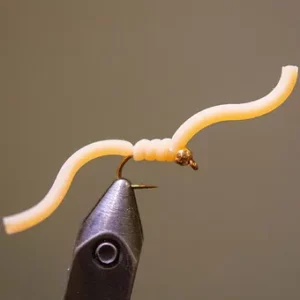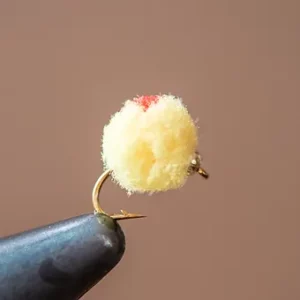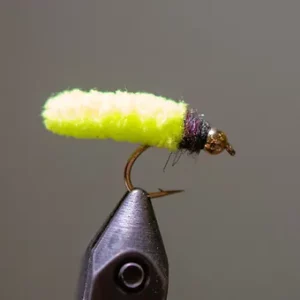Three Flies to Use When Nobody’s Watching
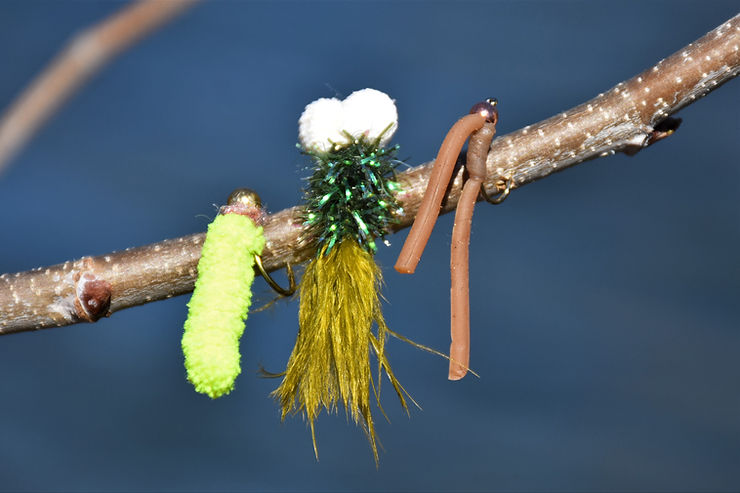
Fly fishing can be frustrating, which often spurs innovation at the vise as we conjure up the next great pattern. But sometimes those creations are borderline embarrassing. It’s a bit demoralizing to think that a trout – epitomized by the wary brown stationed under that old gnarly root – could fall for something as mundane as a hunk of silicone on a hook. And yet all reservations are forgotten once that hooked-jaw beauty is resting in the bottom of the net.
Regardless, here are three flies that might compromise how you look at fly fishing. There’s no doubt that these patterns catch fish, but will you openly admit to using them? Decide for yourself if these patterns will make you blush or grin next time you’re on the water.
The Mop Fly literally consists of parts that Jim Estes scavenged from mops found at a North Carolina dollar store. He discovered that trout loved the fly so he gave a few to his stepson, a competitive fly fisherman. The fly’s popularity rapidly expanded and in June 2016, Lance Egan used the Mop Fly (and others) to win the U.S. National Fly Fishing Championships.
To tie the fly, slide a small bead snug against the eye of the hook and right behind it secure one end of the strand of microfiber from a mop or bathroom rug. Almost every color will catch fish, but pink, white, and chartreuse are common favorites. Ice fibers or hairline dubbing can be added to cover the connection and add sparkle. The tail of the Mop Fly has plenty of lifelike action akin to a big, juicy grub floating in the current.
Booby Fly
 Dolly Parton on a hook, that’s how some fishermen describe the Booby Fly. Make no mistake, though, these flies have proven their worth on trout lakes and big, slow-moving rivers the world over.
Dolly Parton on a hook, that’s how some fishermen describe the Booby Fly. Make no mistake, though, these flies have proven their worth on trout lakes and big, slow-moving rivers the world over.
To be accurate, the Booby Fly is less of a pattern and more of a style of fly tying. Almost any pattern can be tied Booby-style by adding two bulbous eyes to the head of the pattern. This technique was contrived circa 1950s in England. The first Boobies were small nymph patterns that were fished in lakes where insects used a bubble of air to move from the bottom to the surface. The bubble held them in the surface film as they transitioned from nymph to flying adult.
Fly tyers since then have added Boobies to every pattern imaginable, from leaches to crawfish to woolly buggers. High density foam balls, or equivalent materials, are used to imitate the air bubbles. The foam makes the fly a floater, and it’s most effective when fished with a sinking line. After casting out the fly, wait for the line to sink lower in the water column, and then begin retrieving the fly in one-foot strips. With each strip, the weight of the line pulls the fly deeper, but its natural buoyancy pushes it back up toward the surface. In essence, this is a jerkbait-style retrieve that drives trout nuts.
In appearance and design, the Squirmy Wormy is a direct descendent of the San Juan Worm. The distinguishing feature between the two is the material used to create the body, in this case silicone rather than chenille. Place a single strand of Sili Worm fly tying material on the hook so that short sections stick out from the eye of the hook as well as the bend and secure the material to the shank. Whap, bam, instant trout assassin!
This fly can be tied with or without beadheads and it can be fished like any nymph or worm.
The Squirmy Wormy was developed by Dave Hise of North Carolina. In 2014, the U.S. Youth Fly Fishing Team won the World Youth Fly Fishing Championships with the Squirmy Wormy as the cornerstone of their arsenal. In fact, teams from several other countries credited the Squirmy Wormy as the reason for the win and sought to have the fly banned from future events. Fortunately, Team USA dispelled that myth by winning again the following year even though by then their competition was using the Squirmy Wormy, too.
Next time you’re on the water and trout aren’t cooperating, one of these flies just might be the answer. They may lack the aesthetic beauty of classic patterns, but there’s no doubt they catch fish. Eventually you might even admit to using them.
Did You Enjoy Reading About Flies To Use When Nobody's Watching?
Stay up to date with the Dark Skies Fly Fishing monthly newsletter for free and receive the latest posts in fly fishing news, tricks, tips, and techniques, stream reports, as well as updates on new flies added to the Online Store and exclusive discounts!
Sign Up NowCheck Out The Flies Mentioned In This Post
-
Flies
Squirmy Wormie
$1.65 Select options This product has multiple variants. The options may be chosen on the product pageRated 0 out of 5 -
Egg Patterns
Glo Bug
$1.65 Select options This product has multiple variants. The options may be chosen on the product pageRated 0 out of 5 -
Flies
Woolly Bugger
$1.65 Select options This product has multiple variants. The options may be chosen on the product pageRated 0 out of 5 -
Flies
Mop Fly
$1.65 Select options This product has multiple variants. The options may be chosen on the product pageRated 0 out of 5
